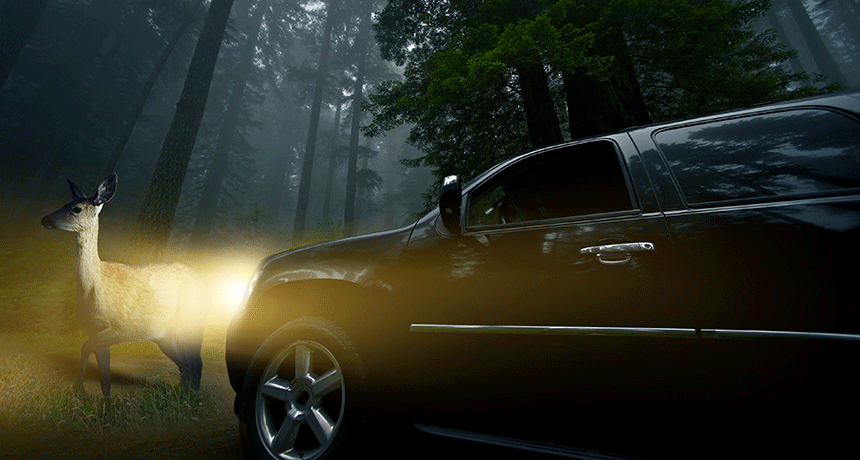Protecting deer with high-pitched noises
Student scientist finds a way to keep deer away from oncoming traffic

Deer and vehicles don’t mix. But how do you keep these animals off the roads? A teen tried sound.
welcomia/istockphoto
Pittsburgh, Pa. — Maegan Yeary’s uncle used to swear by his deer whistle. This is a device that attaches to a car or truck. Wind going through it makes a high-pitched (and annoying) sound. That noise was supposed to keep deer from leaping into the road — and in front of her uncle’s truck.
Except it didn’t. And when he ultimately hit a deer, he “totaled his truck,” she recalls. Her uncle wasn’t hurt. But the accident prompted the 18-year-old senior at J.W. Nixon High School in Laredo, Texas, to look for a new acoustic deer-deterrent.
As she and her uncle discussed the issue, Maegan realized she had the makings of a science-fair project. Her data now show that if people want to keep deer away from highways, they’re going to need a much higher pitched noise than anything a human can hear.
The teen presented her results here, last week, at the Intel International Science and Engineering Fair (ISEF). This yearly competition brings together nearly 1,800 high school finalists from 81 countries. They exhibited their winning science fair projects to the public and competed for almost $5 million in prizes. The Society for Science & the Public created ISEF in 1950 and still runs it. (The Society also publishes Science News for Students and this blog.) This year Intel sponsored the event.
The sound of safety
Deer and humans hear the world differently. Both detect sound waves, measured in hertz — the number of waves, or cycles, per second. A deep sound doesn’t have many cycles per second. High-pitched sounds have a whole lot of them.
People detect sounds in the range of 20 to 20,000 hertz. Deer live life a little higher. They can hear between about 250 and 30,000 hertz. That means deer can hear pitches well above what people can detect.
Her uncle’s deer whistle, though? It sent out a 14,000-hertz sound. That means “people can hear it,” she notes. “It’s an obnoxious sound,” audible even to people riding in a vehicle. And as Maegan’s uncle found, it didn’t send the deer fleeing.

For her experiments, Maegan found a clearing not far from her town that was popular with deer. She set up a speaker and a motion sensor. Then, every other day for three months, she spent late evenings and early mornings hiding near the clearing, waiting for deer.
Each time one arrived, it activated her motion sensor. That triggered a speaker to play a sound. Maegan tested different frequencies — around 4,000, 7,000, 11,000 and 25,000 hertz — to see how the deer responded. She could hear the lower frequencies as “a ringing sound,” the teen explains. “Once they got higher, it’s like a buzz.” By 25,000 hertz, she says, she merely felt what seemed like some “vibration.”
As each tone played, Maegan observed the deer. She wanted to see which, if any, frequencies were annoying enough to make them flee.
None of the lower frequencies did. But when the speakers broadcast 25,000 hertz, Maegan reports, the deer “just walked away.” She also noticed that even then, it only worked for deer no more than about 30 meters (100 feet) away. “Higher frequencies don’t travel as well,” she explains. Deer need to be fairly close to respond.
The teen envisions her warning “whistle” being broadcast from speakers along the sides of a highway. These would warn the deer to stay away — even when there was no car visible. “It’s like a stoplight for animals,” she says. That way it might keep deer at bay — unlike her uncle’s whistle.